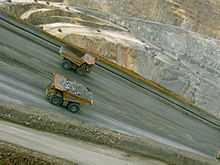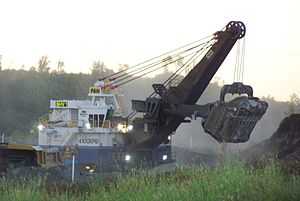Batu Hijau mine
| Location | |
|---|---|
 Batu Hijau Mine Location in Indonesia | |
| Location | Sumbawa |
| Province | West Nusa Tenggara |
| Country | Indonesia |
| Coordinates | 08°58′S 116°52′E / 8.967°S 116.867°ECoordinates: 08°58′S 116°52′E / 8.967°S 116.867°E |
| Production | |
| Products |
Copper Gold |
| Production |
325,500 tonnes copper 719,000 ounces gold |
| Financial year | 2005 |
| History | |
| Opened | 2000 |
| Closed | 2025 |
| Owner | |
| Company | P.T. Newmont Nusa Tenggara |
| Website | P.T. Newmont Nusa Tenggara |
| Year of acquisition | 1990 |
The Batu Hijau mine is an open pit copper-gold mine operated by Newmont Mining Corporation's subsidiary company PT Newmont Nusa Tenggara (PT Newmont). The mine is located 1,530 kilometres (950 mi) east of the Indonesian capital Jakarta on Sumbawa, in southern Taliwang Regency, an island in West Nusa Tenggara. The mine is the result of a ten-year exploration and construction program based on a 1999 discovery of the porphyry copper deposit. Production began in 2000.
The mine utilizes a "truck and shovel" open-pit mining method, with ore reporting to semi-Autogenous Grinding and ball mills, followed by a flotation circuit. The finished product is a thickened copper-gold concentrate, which is shipped via pipe to a storage facility on the Indonesian coast.
The Batu Hijau mine has been the site of ownership disputes between PT Newmont and the Indonesian government based on agreements on the timeframe of which PT Newmont was required to transfer ownership of the mine to the government. There have been environmental controversies with the mine based on PT Newmonts practice of disposal of tailings in the ocean, and waste rock in the rainforest.
History
In 1990 mineral exploration on the island of Sumbawa resulted in the discovery of copper mineralization that would be developed into the Batu Hijau mine.[1] Over the next ten years PT Newmont continued to delineate the resource and began developing the mine and building the required infrastructure. In 1999 construction was complete and by the next year Bata Hijau was producing ore.[2]
Geology
The orebody at Bata Hijau is porphyry copper and includes a high gold component, which is common for a copper deposit in southeast Asia. The host rock for porphyry copper deposits in southeast Asia is typically diorite and quartz-diorite. Copper sulphides such as chalcopyrite and bornite are frequently associated with the gold component of these deposits. As of the end of 2005 the remaining ore reserves at the Batu Hijau included 2.77 million tonnes of copper with an average grade of 0.69g/t gold, which would allow mining to continue until 2025.[2]
Mining & milling

Batu Hijau is an open-pit mine. Ore is removed from the mining face using P&H 4100 electric shovels (pictured) and loaded into Caterpillar 793C haul trucks. Each haul truck can move a payload 220 t (240 short tons) of ore. The trucks haul ore from the shovel to primary crushers. Crushed ore is sent by a conveyor 1.8 m (6 ft) wide and 6.8 km (4.2 mi) long to the mill. Daily production from the mine is an average of 600,000 t (660,000 short tons) ore and waste combined. Ore from the mine has an average copper grade of 0.49% and an average gold grade of 0.39g/t.[2]
Crushed ore is further reduced in size by Semi-Autogenous Grinding and ball mills. Once milled it is sent through a flotation circuit which produces a concentrate with a grade of 32% copper and 19.9g/t gold.[2] The mill realizes a copper recovery of 89%.[3] The concentrate is thickened into slurry and piped 17.6 km (10.9 mi) to the port at Benete where water is removed from the slurry. The concentrate storage at the port can hold 80,000 t (88,000 short tons) of copper-gold concentrate.[2]
Ownership and operation disputes

The Batu Hijau mine is owned by three independent parties with varying percentages of ownership. PT Newmont controls 45%, Nusa Tenggara Mining Corporation (owned by the Japanese company Sumitomo)[4] controls 35% with PT Pukuafu Indah (an Indonesian company) controlling the remaining 20%.[2][5] Before production began at Batu Hijau Newmont and Sumitomo signed a contract with the Indonesian government that allowed the two foreign companies to operate the mine until 2030 provided 51% of the mine was sold to domestic investors by 2010. The Indonesian government was to be given the first offer to purchase. In 2006 and 2007 Newmont offered to sell a combined 10% of PT Newmont to the Indonesian government for a total of $391 million. The government did not have the money to move forward with the investment and declined to purchase.[5] Local governments on the island of Sumbawa wanted to purchase the stake in PT Newmont that the federal government passed on, with Newmont refusing to sell insisting that the governments were funded by unknown groups in the private sector[5] and Newmont wanted control over who purchased the company.[6]
By the end of March 2008 a total of 17% of PT Newmont was to be sold to Indonesian investors. When Newmont had not sold the required percentage of PT Newmont to Indonesian parties as required the Indonesian government requested arbitration from United Nations Commission on International Trade Law.[7] The Indonesian government had hoped that in arbitration Newmont would be found in breach of contract and would be required to turn over control of the company to the government without compensation. On April 1, 2009 the arbitration committee declared that Newmont would not have to turn over complete control of PT Newmont to the Indonesian government, but was still required to sell the 17% to the government (or a buyer designated by the government) as committed. Newmont was given 180 days to complete the sale.[6]
Along with other Indonesian mining companies, PT Newmont was ordered to cease exporting unfinished product (its copper-gold concentrate). There was no smelter in Indonesia able to process the concentrate, though one was being considered for the future. PTNNT employees threatened to stage mass demonstrations over the possible loss of their jobs.[8] The dispute lasted until August 2014, when PT Newmont Nusa Tenggara and the Indonesian government agreed to settle their differences over the export restrictions which had resulted in the temporary closing of the Batu Hijau mine. . Upon the signing of a Memorandum of Understanding it was expected that exports from the mine would resume, while it was also agreed a new smelter would be built.[9]
Environmental issues
Disposal of tailings from the processing operation of the Batu Hijau mine takes place in the ocean, using a process called Submarine Tailings Disposal (STD). Indonesia is currently the only location that Newmont uses this process, claiming that it is more an environmentally sound practice despite being more costly to the company. The process involves piping the tailings 2.1 miles (3.4 km) off the coast to a drop-off of 400 feet (120 m), which carries the waste down another 10,000 feet (3,000 m). Waste rock from the Batu Hijau mine is disposed of in the rainforest, with space for newly produced waste rock running out. Environmentalists are raising concern with the declining population of the Yellow-crested Cockatoo. Newmont's request to expand their permit to clear an additional 79 acres (0.32 km2) of rainforest has not been approved.[10]
References
- ↑ "Batu Hijau mine site - Infomine". InfoMine. Retrieved 2009-04-03.
- ↑ 2.0 2.1 2.2 2.3 2.4 2.5 "Batu Hijau Copper-Gold Mine, Indonesia". Mining Technology. Archived from the original on 16 April 2009. Retrieved 2009-04-02.
- ↑ Tse, Pui-Kwan (2002). "The Mineral Industries of Indonesia and East Timor (Timor Leste)" (PDF). United States Geological Survey.
- ↑ Hill, Liezel (March 18, 2009). "Newmont expects ruling on Indonesia divestiture by mid-year". Creamer Media's Mining Weekly. Retrieved 2009-04-02.
- ↑ 5.0 5.1 5.2 Wright, Tom (April 2, 2009). "Panel Affirms Newmont's Right to Run Indonesian Mine". The Wall Street Journal. Retrieved 2009-04-02.
- ↑ 6.0 6.1 McDowell, Robin (April 1, 2009). "Newmont Told to Sell Shares in Indonesian Unit". Associated Press Via ABC. Retrieved 2009-04-02.
- ↑ Selamat, Fawziah; Edhi Pranasidhi (March 4, 2008). "Jakarta, Newmont Take Fight to U.N.". The Wall Street Journal. Retrieved 2009-04-02.
- ↑ PTNNT News, accessed 01/18/2014
- ↑ "Newmont to restart mining with withdrawal of arbitration case". Indonesia News.Net. 26 August 2014. Retrieved 27 August 2014.
- ↑ Larmer, Brook (January 2009). "The Real Price of Gold". National Geographic.
External links
- Batu Hijau Mine at Newmont Mining website
| ||||||||||||||||||||||||||||||